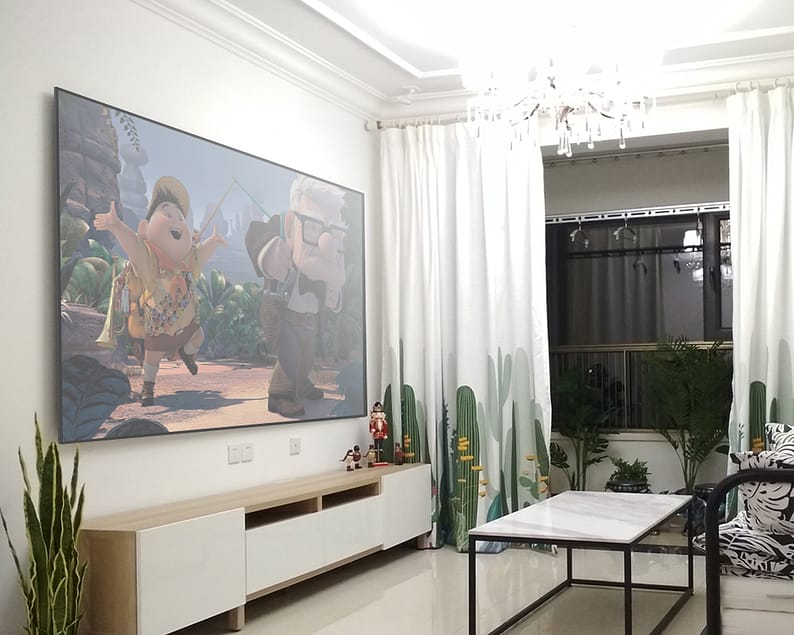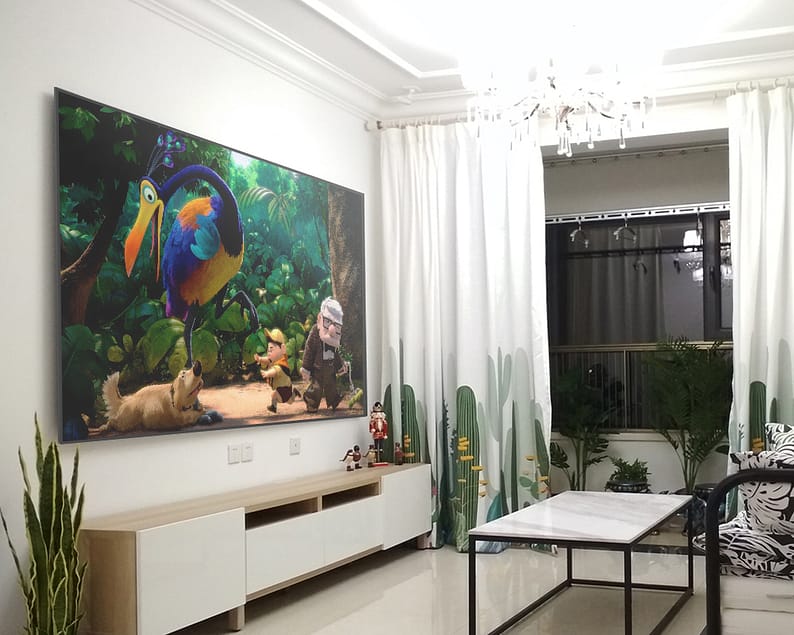Jet ultra-court lprojecteurs ASER font des vagues dans le monde de la technologie, et avec eux, leurs écrans spéciaux ont également attiré l'attention du public. Comment fonctionnent ces écrans? Valent-ils l'investissement? Plongeons et découvrons l'histoire derrière eux.
Qu'est-ce qu'un écran ALR?
Un Écran ALL, debout pour l'écran de rejet de lumière ambiante, est essentiellement un écran conçu pour lutter contre la lumière ambiante. Pour comprendre ce concept, nous devons d'abord définir ce qu'est la lumière ambiante.
Qu'est-ce que la lumière ambiante?
La lumière ambiante, en termes simples, fait référence à toute la lumière qui nous entoure, y compris à la fois la lumière naturelle du soleil et l'éclairage intérieur. Il ne vient pas d'une seule direction spécifique mais est dispersé à partir de diverses sources.
Autrement dit:
Ce sont ces sources de lumière incontrôlables, comme la lumière du soleil des fenêtres ou les luminaires à l'intérieur d'une pièce.
Comment la lumière ambiante affecte-t-elle les écrans?
Lorsque la lumière ambiante frappe directement un écran, il se mélange avec la lumière projetée à partir du projecteur. En conséquence, l'image que vous voyez pourrait perdre son contraste, apparaissant faible et manquant de détails.


Essentiellement:
La forte lumière ambiante peut déformer l'image à l'écran, ce qui la rend floue ou provoque des inexactitudes de couleurs.
Pour lutter contre l'influence de la lumière ambiante, vous pouvez:
- Ont un théâtre domestique complètement fermé, qui atténue considérablement les effets de la lumière ambiante.
- Si ce qui précède n'est pas possible et que vous installez un théâtre maison dans votre salon, des rideaux épais peuvent vous aider. De plus, si votre projecteur est suffisamment brillant, il peut quelque peu remplacer les effets de la lumière ambiante. Cependant, une visualisation prolongée sur un écran trop brillant peut entraîner une fatigue ou une inconfort des yeux.
- Si vous trouvez les solutions ci-dessus difficiles à réaliser, un écran ALR / CLR peut facilement relever ces défis.
Ainsi, la fonction principale d'un écran ALL est le rejet de lumière ambiante.
Comment fonctionne un écran ALL?
Pour comprendre le fonctionnement des écrans ALL, nous avons d'abord besoin d'une compréhension de base du fonctionnement des écrans réguliers.
Quelle est la différence entre les écrans ALR et Normal Projecteur?
Écran de projecteur normal:
Les écrans traditionnels agissent essentiellement comme un mur blanc, reflétant uniformément la lumière.
Dans un environnement sombre, l'écran reflète toute la lumière. L'image projetée est généralement brillante.
Cependant, dans des endroits avec une lumière ambiante, un écran régulier reflète également cette lumière environnementale. Il en résulte une diminution du contraste dans l'image projetée, transformant les noirs en gris et faisant apparaître l'image globale lavée.
De plus, on pourrait même observer les reflets ou les taches légères en raison de sources lumineuses, de distraire le spectateur et de diminuer l'expérience de visionnement.
Écran ALR:
Les écrans ALL utilisent souvent un matériau noir unique, appelé écrans de grille noire et présentent une conception structurelle spécifique. Cette conception permet à l'écran de refléter la lumière sélectivement.
Autrement dit: il reflète le maximum de la lumière du projecteur tout en reflétant minimalement la lumière environnementale.
En outre, les matériaux diffusants multicouches de l'écran éradiquent davantage l'effet de lavage de la lumière ambiante, améliorant simultanément les niveaux noirs, résultant en une image plus claire.
Quelle est la différence entre les écrans ALR et CLR?
Les deux sont conçus pour offrir une expérience visuelle améliorée, et en surface, ils semblent distincts.
Écrans ALR (rejet de lumière ambiante):
Principe de travail: grâce à des matériaux et à la structure spécialisés, les écrans ALL peuvent refléter la lumière du projecteur tout en minimisant la réflexion de la lumière ambiante à partir d'autres directions.
CLR (Rejet de plafond) Écrans:
Principe de travail: les écrans CLR sont conçus de manière unique pour rejeter principalement la lumière provenant d'en haut, reflétant efficacement la lumière provenant d'en bas (c'est-à-dire du projecteur).
Cependant, visuellement, il n'y a pas beaucoup de différence entre les deux.
Avant d'acheter, assurez-vous qu'il est spécialement conçu pour les projecteurs à lancement ultra-court. Certains écrans ALL / CLR sont adaptés aux projecteurs à lancer court / long, et la qualité visuelle peut différer considérablement.
Pour les avantages et les inconvénients des écrans ALL:
Avantages:
Rejet de lumière ambiante: le principal avantage est sa conception de base - pour offrir une qualité d'image supérieure dans des conditions de lumière ambiante. Par rapport aux écrans traditionnels ou aux murs blancs, les écrans ALL peuvent réduire considérablement les réflexions de la lumière ambiante.
Contrast amélioré: Dans les environnements brillamment éclairés, les écrans ALL peuvent fournir un contraste plus élevé, rendant les images plus dynamiques.
Fidélité des couleurs: avec une interférence réduite de la lumière ambiante, les écrans ALL peuvent mieux préserver les effets de couleur d'origine.
Adaptabilité: Pour les paramètres où le contrôle de la lumière est difficile, comme les espaces de vie, les bureaux ouverts ou les espaces commerciaux, les écrans ALL sont parfaits.
Inconvénients:
Performance in the Dark: Dans une salle de pitch, les avantages d'un écran ALL peuvent ne pas être évidents, et ses performances peuvent s'apparenter à des écrans traditionnels ou à des murs simples.
Prix: En raison de leur conception spécialisée et de leur matériel, les écrans ALL ont tendance à être plus chers que les écrans conventionnels.
Installation et ajustement: les écrans ALL peuvent avoir des exigences plus strictes concernant le placement et l'angle du projecteur, nécessitant des ajustements précis pour des résultats optimaux.
Affichage des restrictions d'angle: certains écrans ALL peuvent avoir un angle de vision plus étroit, ce qui signifie que la qualité de l'image peut se détériorer lorsqu'elle est vue sur les côtés.
À Nothingprojector, Nos écrans ALR / CLR ont un angle de vision allant jusqu'à 170 degrés, ce qui les rend parfaits pour profiter du charme cinématographique en famille.
Puis-je utiliser un projecteur ordinaire sur un écran ALL?
Actuellement, le marché propose des écrans ALL spécialement conçus pour les projecteurs à lancement ultra-court et ceux adaptés aux projecteurs à lancer court / long.
Les effets visuels résultants peuvent différer considérablement si les types d'écran et de projecteur sont incompatibles.
Il est crucial de clarifier cela avec le vendeur avant d'acheter.




